Underground Flow Equalization System
What Is the Underground Flow Equalization System and Why Is It Important?
The City of San Mateo is currently under a Cease and Desist Order issued by the Regional Water Quality Control Board to eliminate sanitary sewer overflows (SSOs). The Underground Flow Equalization System (UFES) consists of an underground 5.3 million gallon structure that will help eliminate SSOs in San Mateo and comply with the Cease and Desist Order. SSOs occur primarily during heavy rains, when excess water enters the sewer collection system and overwhelms its capacity. During these events, sewage flows out of the system onto the City’s streets.
A Proven Technology
These facilities are becoming more widely used across the entire country to provide additional capacity in sewer systems during heavy rains to help prevent sewer overflows. Seattle, Sacramento, and Daly City use them, and the city of Pacifica is in the process of constructing a similar system that will open this year.
 Where Will the UFES Be Located?
Where Will the UFES Be Located?
The UFES will be located on the San Mateo County Event Center property between Saratoga Drive and South Delaware Street. After an extensive site selection process, including more than 20 public meetings and hearings, the east corner of the Event Center parking lot was determined to be the most feasible location. Several presentations on UFES and the site selection process can be found on our Presentations page.
How Will the 5.3 MG Underground Structure Be Built?
 Construction will be done in six phases:
Construction will be done in six phases:
- Site Preparation
- Shoring Installation
- Excavation
- Foundation Micro-Pile Installation
- Concrete
- Site Finishing
Download the full construction presentation here.
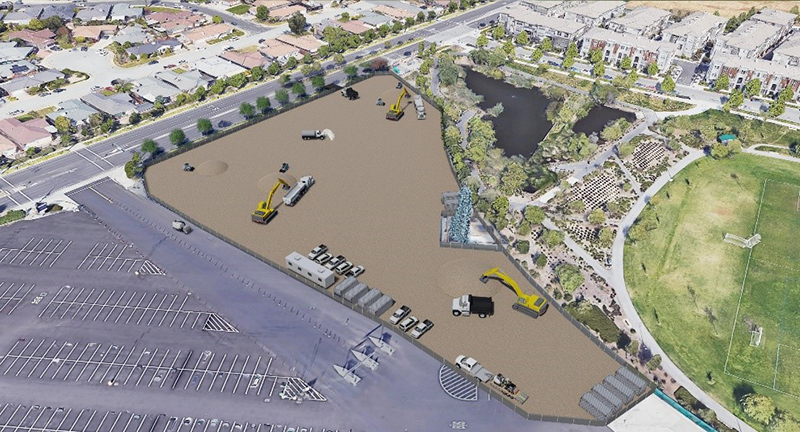 Representation of Site Preparation
Representation of Site Preparation
Phase 1: Site Preparation
During this phase, the site will be cleared, construction trailers and equipment will be brought to the site, construction fencing will be installed, and dust control measures will be in place.
At this time, equipment to monitor groundwater, vibration, and noise will be installed. A pre-construction survey of neighboring properties will also be conducted to assess the existing conditions and monitor for settlement.
Phase 2: Shoring Installation and Dewatering
The shoring system will safely hold the area open during excavation. During this phase, shoring construction equipment will be brought to the site. The contractor will select one of three low vibration and noise systems for the installation of the shoring system. It is important to note that no sheet piles will be used on this project.
Once the shoring equipment is installed, groundwater will be pumped out of the work area. The soil and groundwater have been tested to confirm there is no contamination. Additionally, dewatering tests were performed to observe groundwater level fluctuations in nearby wells. Water will be removed (dewatering) from inside the shoring to maintain stability. This dewatering method will not cause the groundwater levels to change from typical conditions beyond the property line.
The City will survey and document nearby structures before, during, and after construction. During construction, the City will monitor groundwater levels, noise, and vibration. Enforceable thresholds will be set and enforced, where work can be stopped if work exceeds the specified limits.
This work is expected to take approximately 4 months.
 Representation of Shoring Installation
Representation of Shoring Installation
The figures below show the effects of dewatering from the construction site and groundwater levels with regard to the Bay Meadows and Fiesta Gardens neighborhoods. The City will continue to survey and monitor nearby structures during construction.
 Controlling Groundwater in the Bay Meadows Neighborhood
Controlling Groundwater in the Bay Meadows Neighborhood
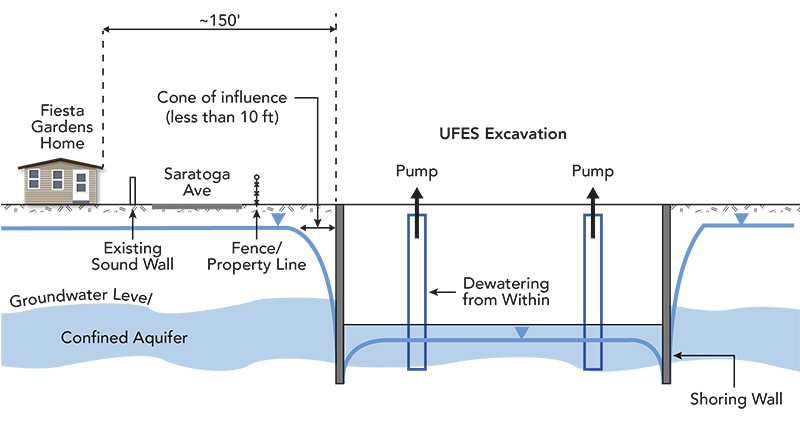 Controlling Groundwater in the Fiesta Gardens Neighborhood
Controlling Groundwater in the Fiesta Gardens Neighborhood
 Representation of Excavation Work
Representation of Excavation Work
Phase 3: Excavation
Once the shoring is complete, excavation will begin and the soil inside the shoring will be removed. During this phase, the City will monitor groundwater, vibration, and noise levels. Dust control measures will be in place.
This work is expected to take approximately 3 months.
Phase 4: Foundation Micro-Pile Installation
A network of foundation piles will be drilled to prevent uplift (floating) from the high groundwater levels, to support the structure and to keep it in place during seismic events. Seven different pile types and installation methods were evaluated. Micro-piles were selected because they meet the technical requirements, while being quieter and having less vibration than other methods. During this phase, approximately 270 micro-piles will be installed. The City will continue to monitor for groundwater levels, vibration and noise.
This work is expected to take approximately 2 months.
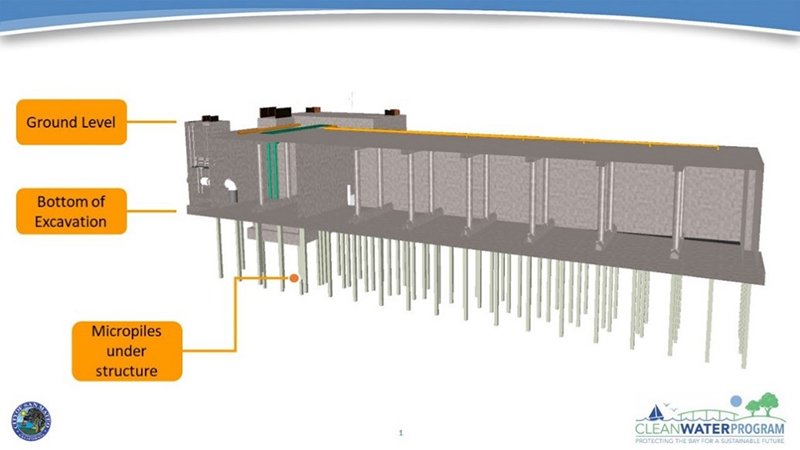 Representation of Micro-Piles under UFES Structure
Representation of Micro-Piles under UFES Structure
 Noise from the installation of the micro-piles is expected be below the City’s noise ordinance – this sets a level of 90 dBA at the property line. The City will monitor noise throughout the construction process.
Noise from the installation of the micro-piles is expected be below the City’s noise ordinance – this sets a level of 90 dBA at the property line. The City will monitor noise throughout the construction process.
The figures below show the expected noise levels during the installation of the micro-piles from the site with regard to the Bay Meadows and Fiesta Gardens neighborhoods.
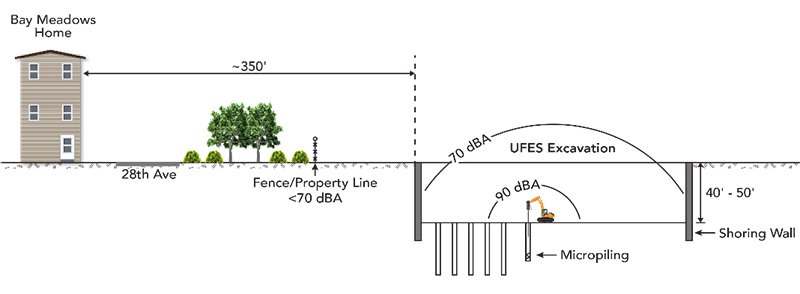 Section Showing Anticipated Sound Levels from Micropiling Activities in the Bay Meadows Neighborhood
Section Showing Anticipated Sound Levels from Micropiling Activities in the Bay Meadows Neighborhood
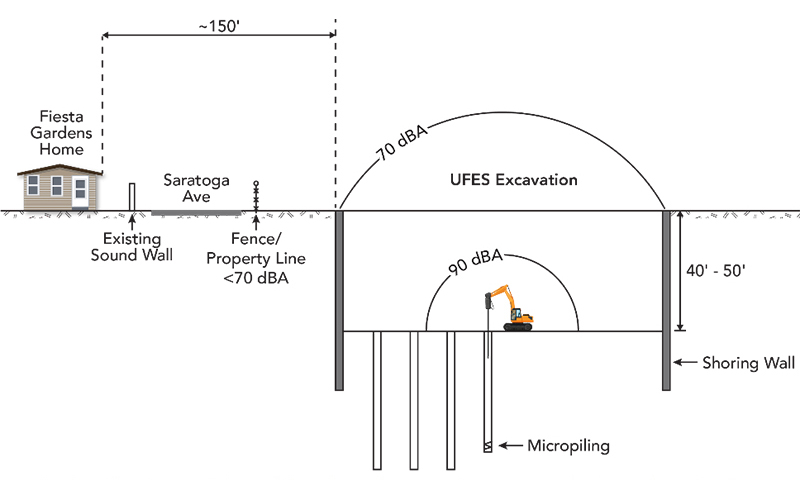 Section Showing Anticipated Sound Levels from Micropiling Activities in the Fiesta Gardens Neighborhood
Section Showing Anticipated Sound Levels from Micropiling Activities in the Fiesta Gardens Neighborhood
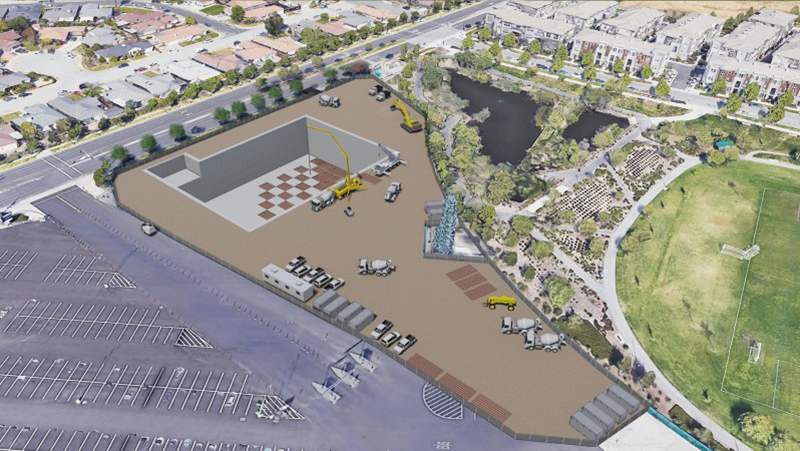 Representation of Phase 5 Work
Representation of Phase 5 Work
Phase 5: Concrete
In Phase 5, the concrete base, walls, column, beams, and roof elements of the UFES structure will be built. Concrete trucks and pumping equipment will be on site.
The City will continue to monitor for groundwater, vibration, and noise throughout this phase. The duration of this work is expected to be 9 months.
Phase 6: Site Finishing
Once the concrete is done, the new electrical building will be installed, in addition to new plantings and fencing along Saratoga Drive and new pavement. The permanent, active odor control facility will be installed (on the far west portion of the site, away from the park). The remainder of the site will be repaved and restored to Event Center usage.
The construction crews will be demobilized, and the new facility will undergo startup and testing.
The City will continue to monitor for groundwater, vibration, and noise throughout this phase. A post-construction survey will also be done to assess the neighboring properties. The duration of this work is expected to be 8 months.
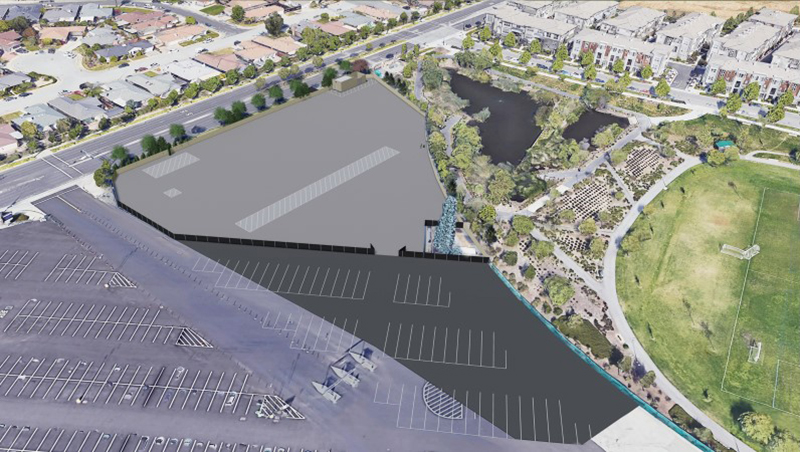 Representation of Phase 6 Finished Site
Representation of Phase 6 Finished Site
 How Will the Diversion Structure, Diversion Sewers, and Force Main Be Built?
How Will the Diversion Structure, Diversion Sewers, and Force Main Be Built?
To transport wastewater to the UFES, a diversion system, which comprises of a diversion structure, diversion sewers, and force main, is required along Delaware Street and Saratoga Avenue. This diversion system will divert excess flows off of the Delaware sewer trunk line, to prevent SSOs, and convey the excess flows to the 5.3 MG underground structure.
The diversion structure will be installed south of the intersection of Saratoga Avenue and Delaware Street. A new 36-inch diversion sewer will be installed using open trench construction along portions of Saratoga Avenue and Delaware Street. Trenchless construction methods (pipe lining of an existing pipe and horizontal directional drilling for a new segment of pipe) will be used for an 18-inch force main along portions of Saratoga Avenue and Delaware Street.
Traffic Management
Traffic control and management will be in place for the duration of the UFES and pipeline work. Construction traffic will be routed from the construction site to the nearest designated haul routes (City of San Mateo Truck Route Program).

Dust Control
Dust control measures will be implemented throughout construction. This includes wet sweeping on surrounding streets and around the construction site, covering any truck beds hauling off dirt, site watering, tire washing facilities, and screening the site.
Future Operations and Maintenance
The UFES will be used during heavy storms, as well as for some collection system maintenance and inspection activities. It is expected to be used fewer than 20 times per year on average. During use, it will temporarily hold flows for up to 24 hours.
Dry Weather Conditions
During dry weather, the flow equalization system will rarely be used, except for maintenance and diversion, because the wastewater collection system has sufficient capacity.
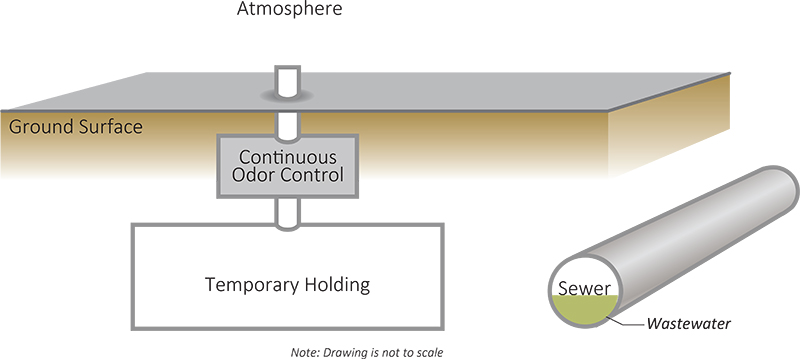
Maintenance/Diversion
The equalization system will also provide temporary storage, or holding, to facilitate future sewer construction projects and operations and maintenance activities, such as pipeline inspection and cleaning.
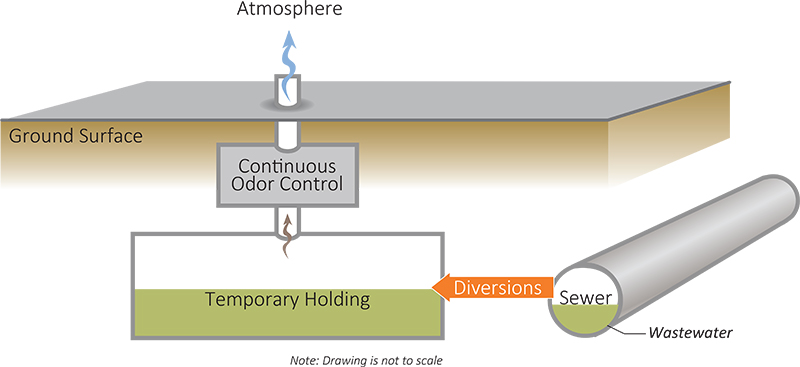
During Heavy Rains
During storms, rainwater gets into the wastewater collection system and overwhelms its capacity. The excess, rain-diluted wastewater will be redirected to the temporary holding area to prevent overflows and to allow the system to “catch up.”
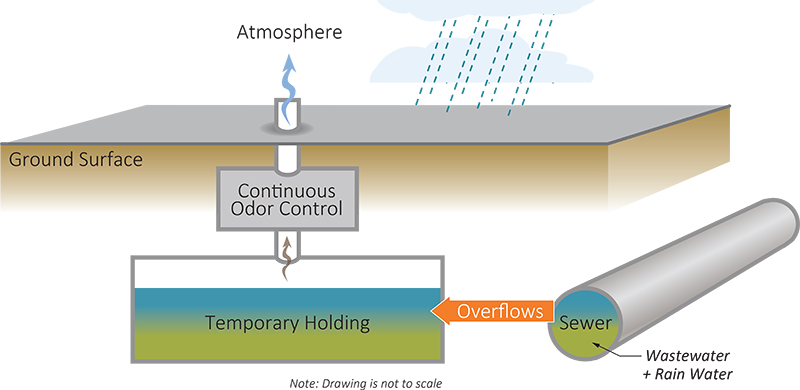
After Heavy Rains or Maintenance/Diversion
After the storm subsides, the diluted wastewater is released from the equalization system into the main wastewater collection system and sent to the treatment plant. When the system has been used for maintenance, the wastewater returned to the main collection system will not be diluted. Self-cleaning mechanisms are activated to flush and clean the equalization system, all while odor control is in effect.

Continuous Odor Control
After each use, the holding structure will be emptied and cleaned via large tipping buckets. Odor control facilities will be in continuous operation . The UFES will be inspected by the City after each use.
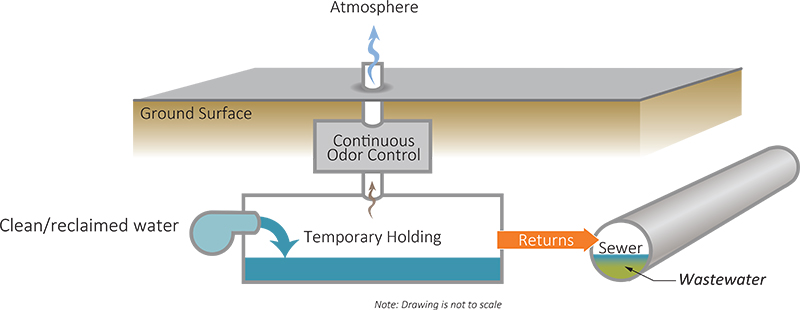
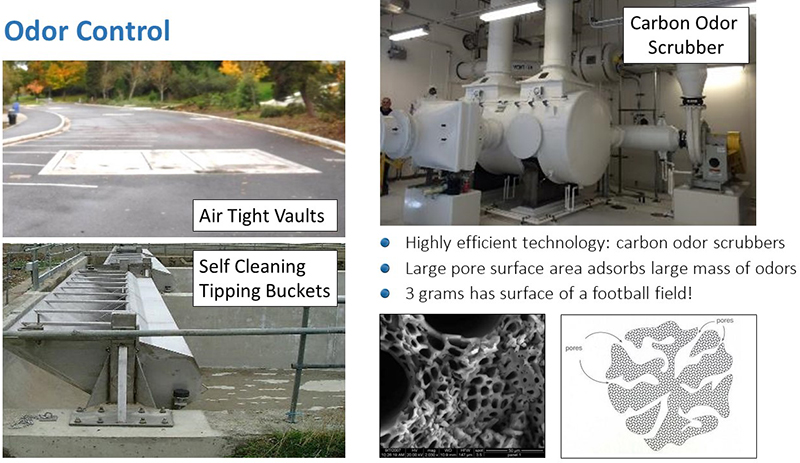
The CEQA Process
The Final Environmental Impact Report for this project is now available at the links below. Hard copies are also be available at City Hall and the San Mateo Main Library.
The Final EIR incorporates written responses to comments received during the public comment period, which ran from March 6, 2019 through May 31, 2019. The Final EIR will be presented to the Planning Commission and City Council for consideration of adoption.




